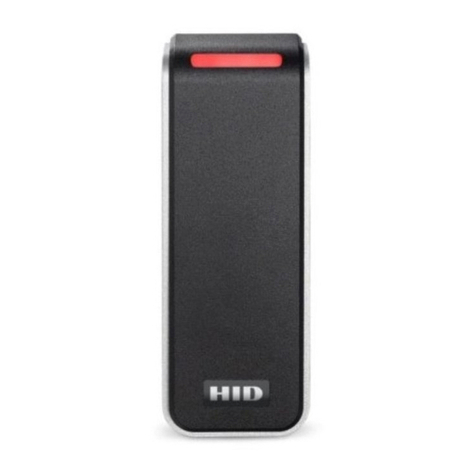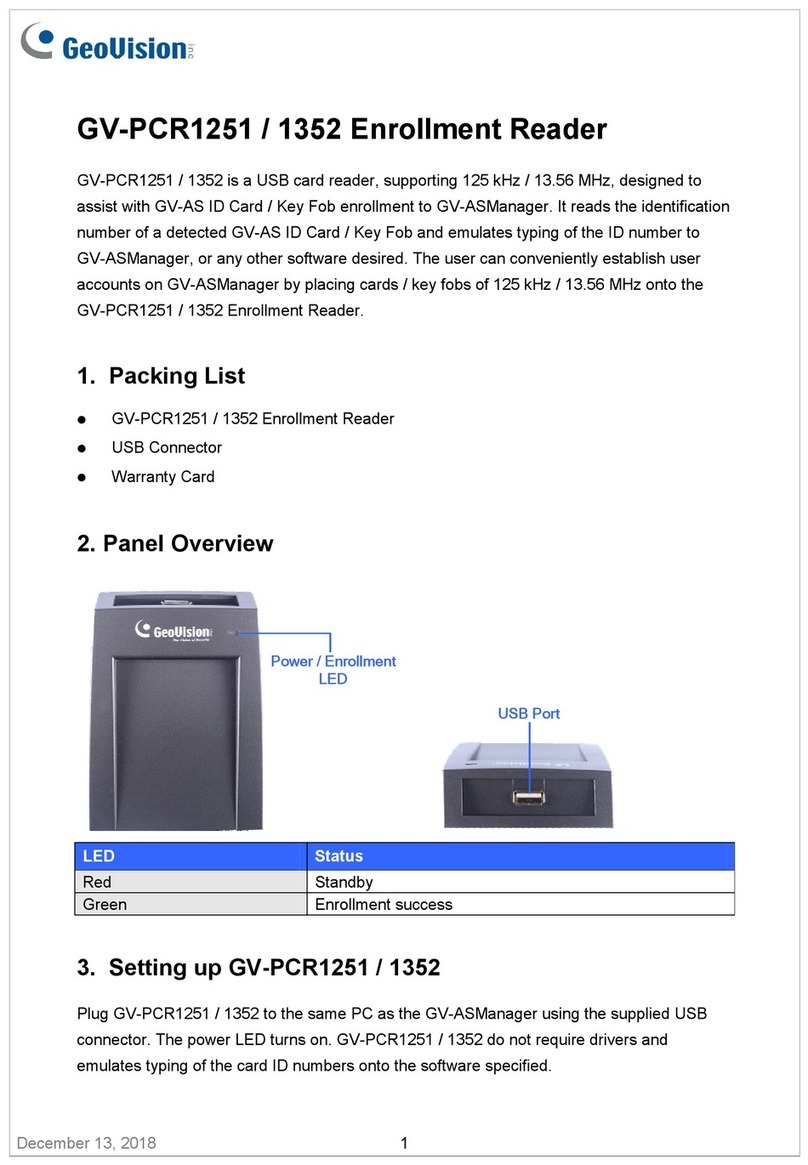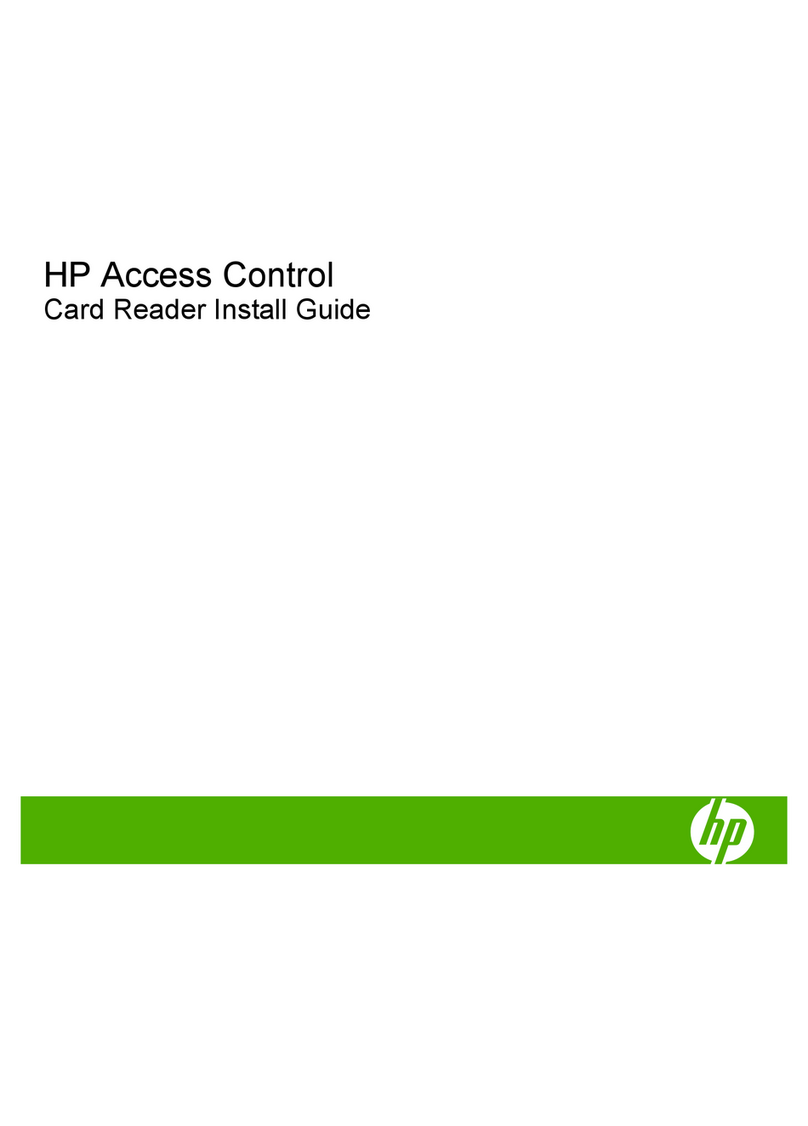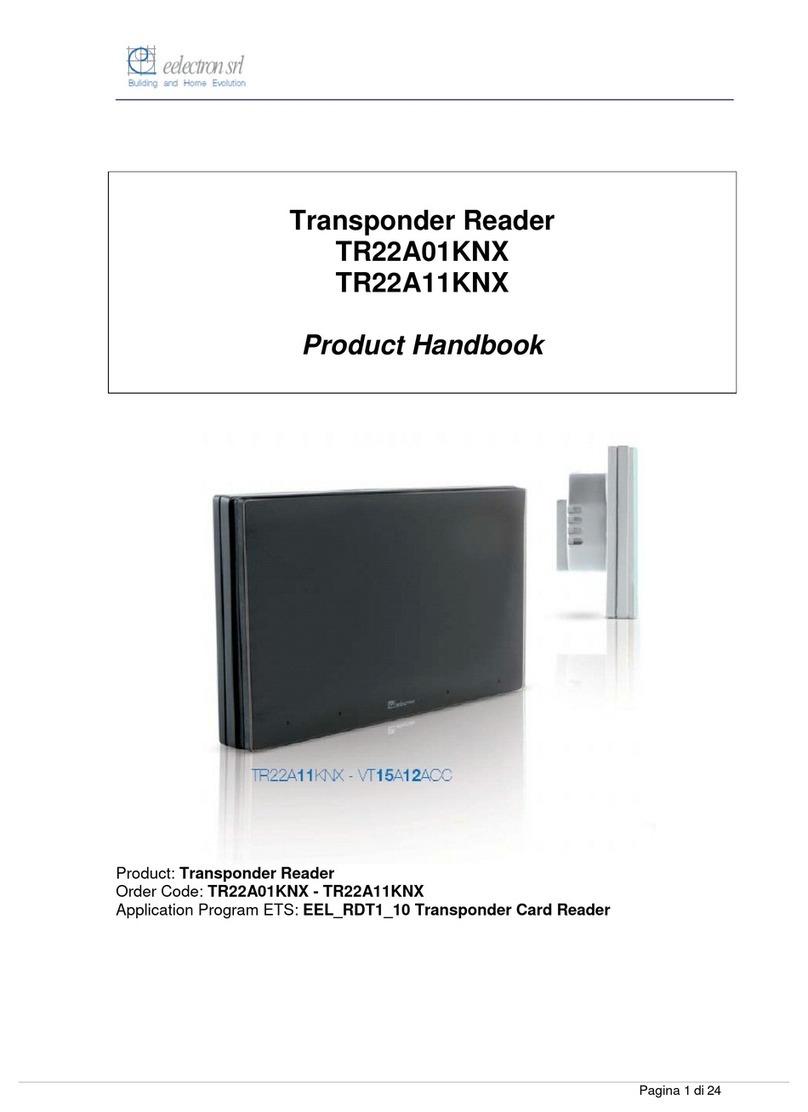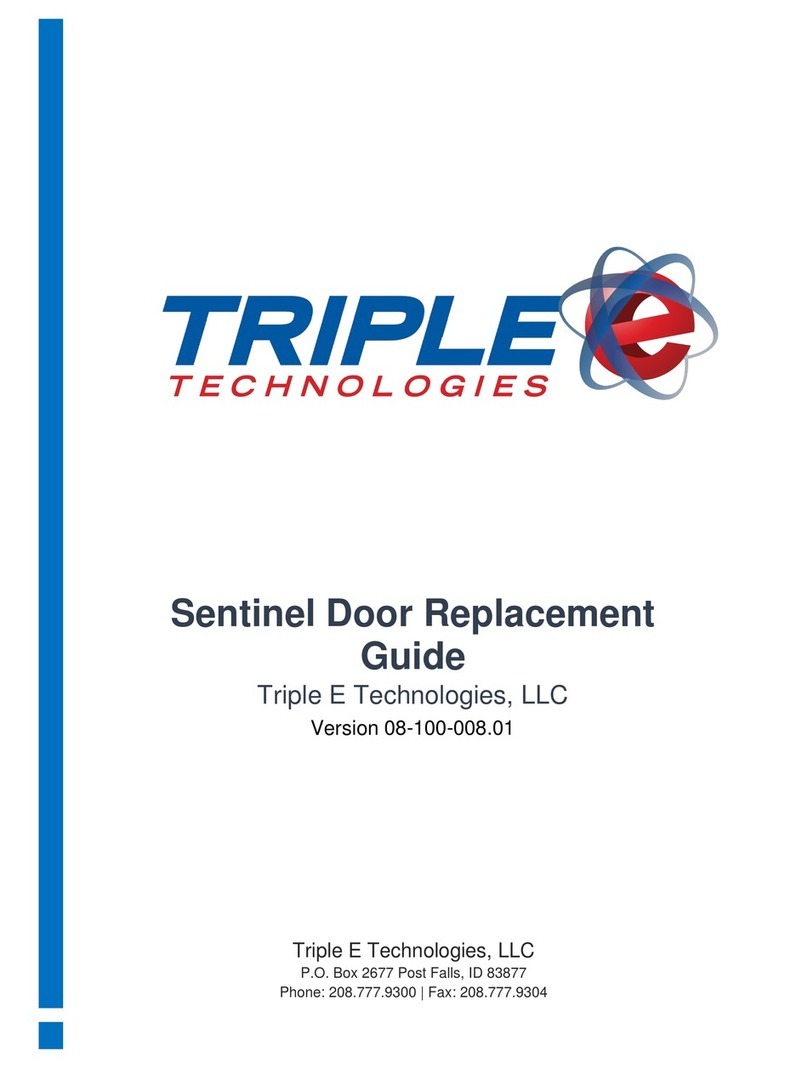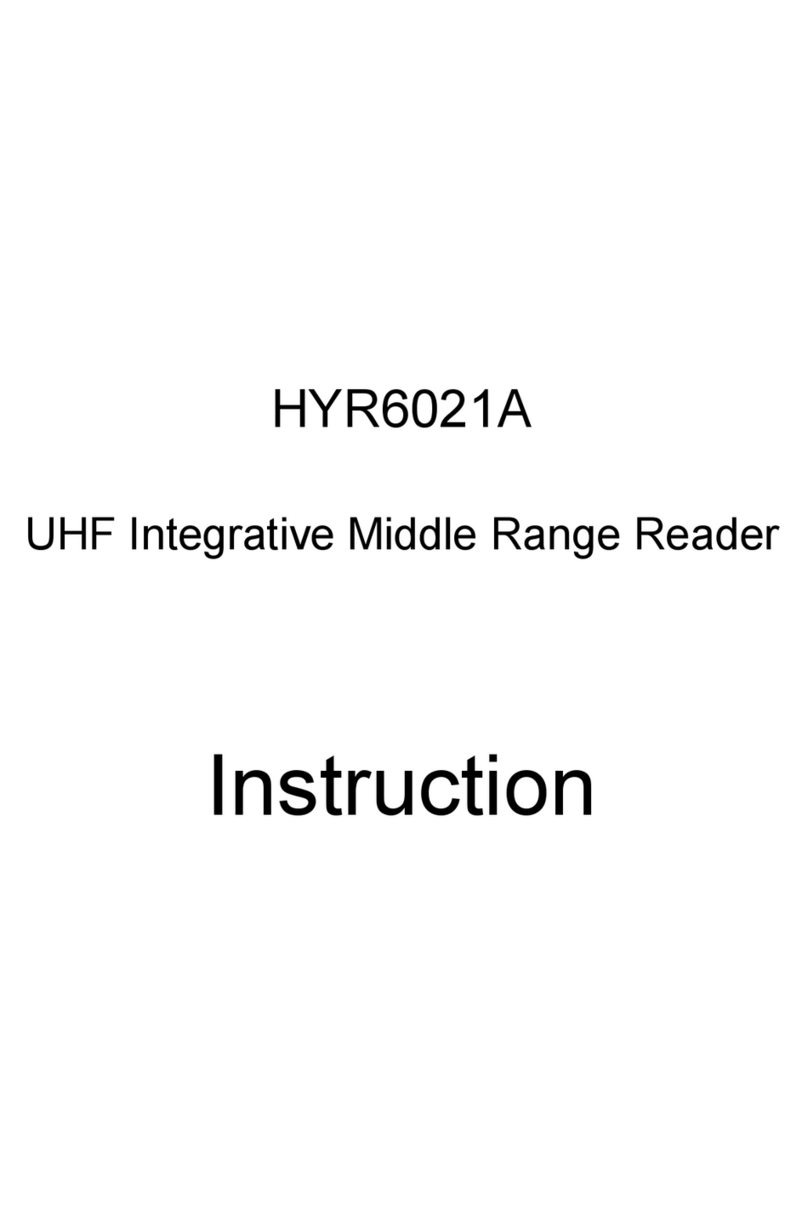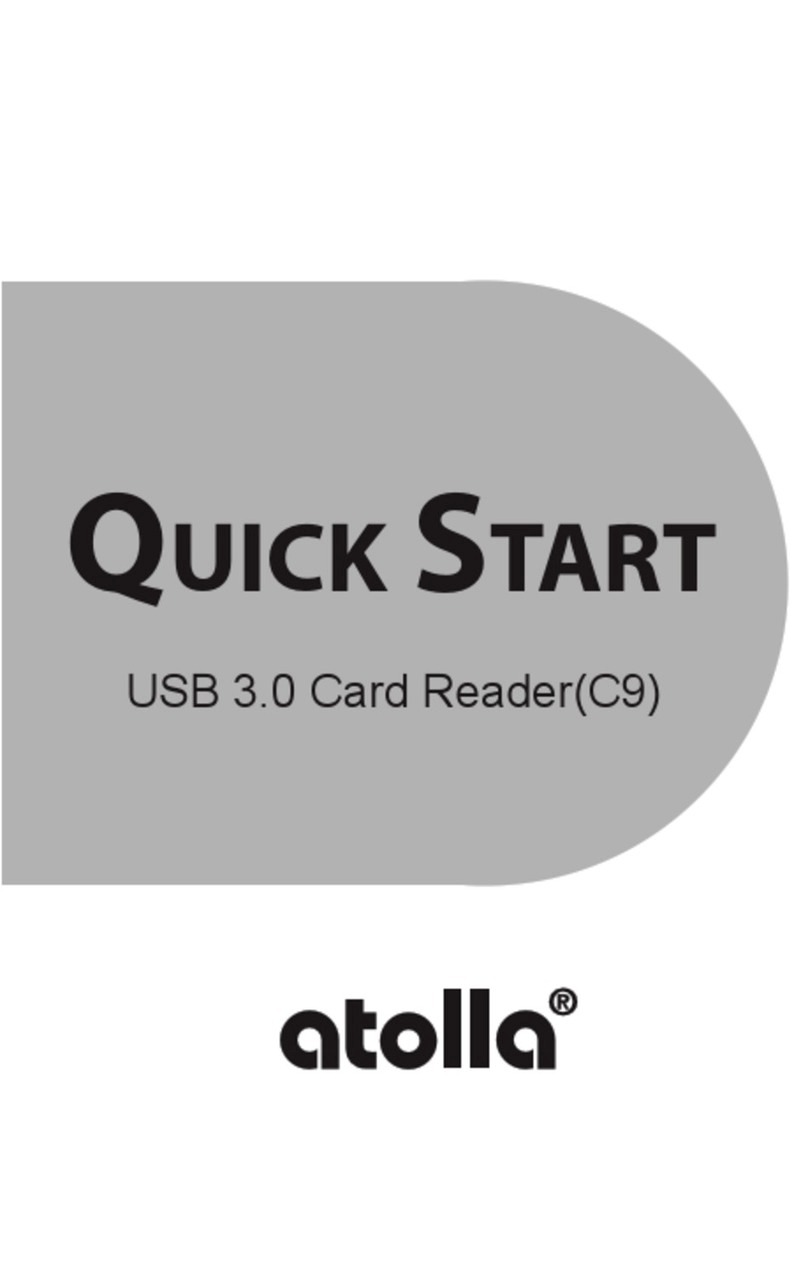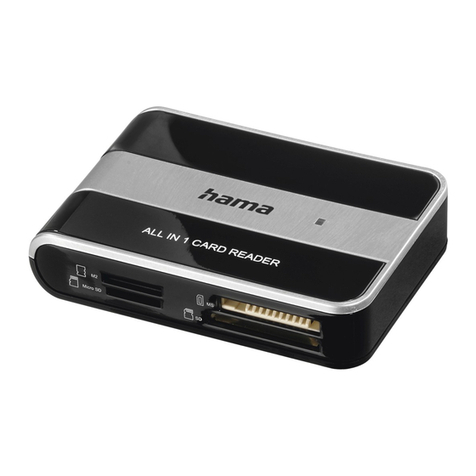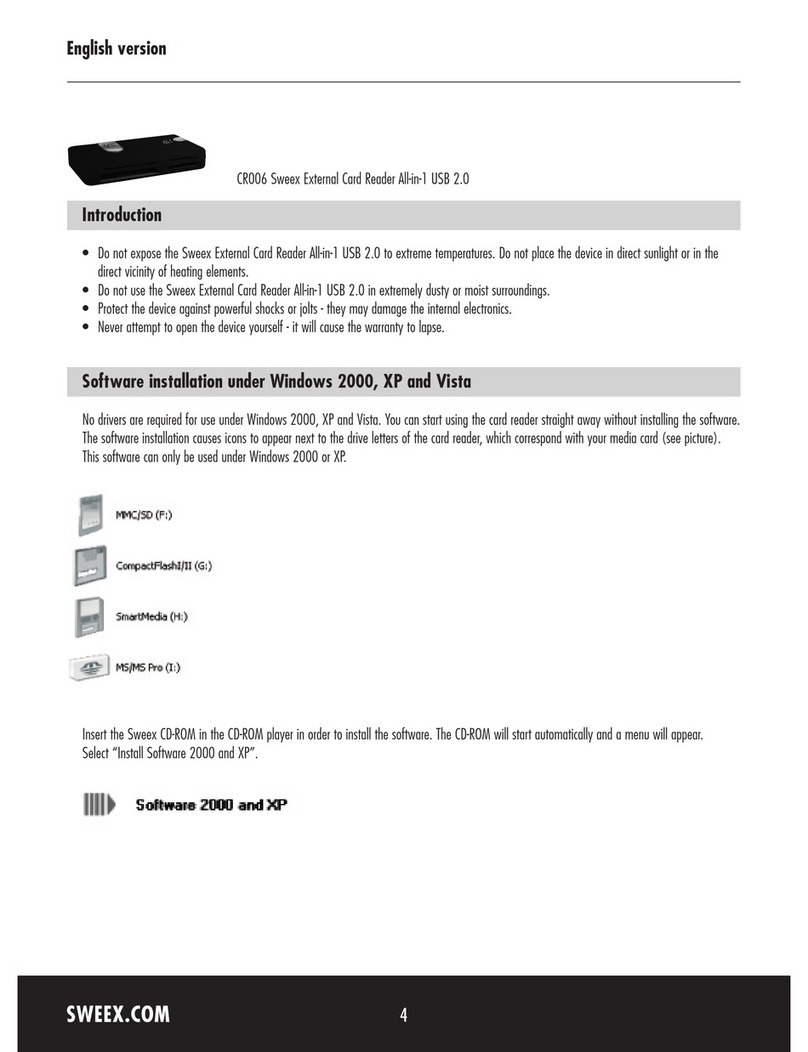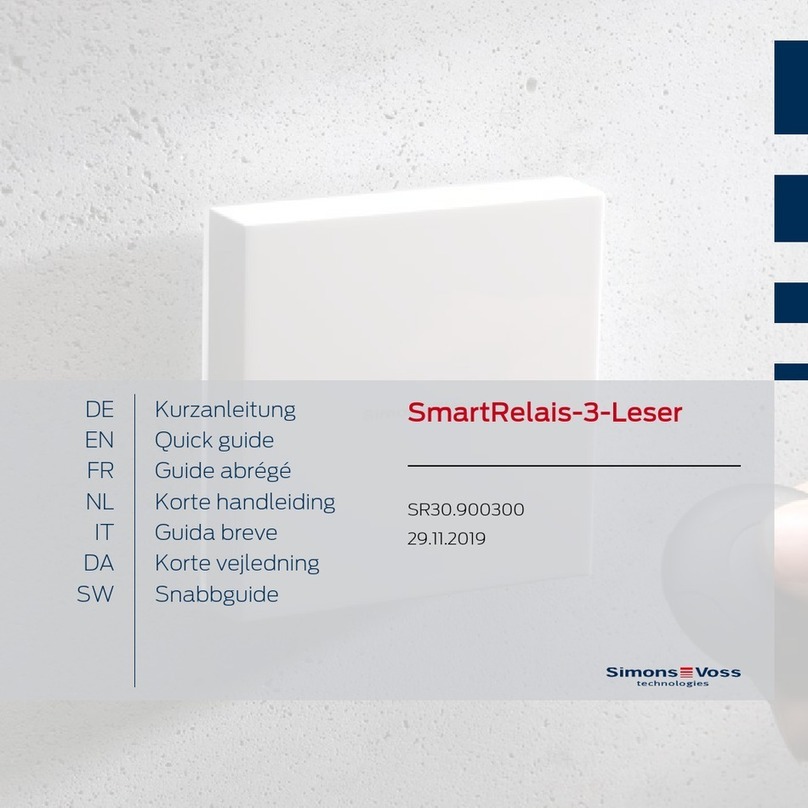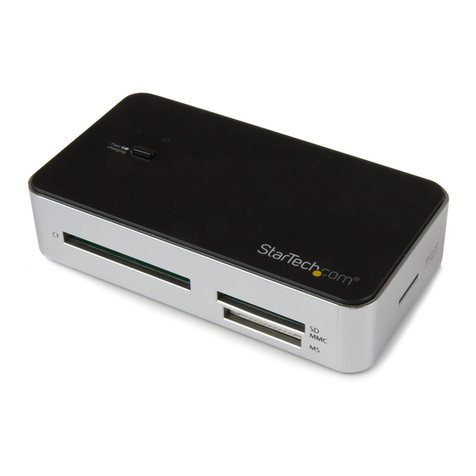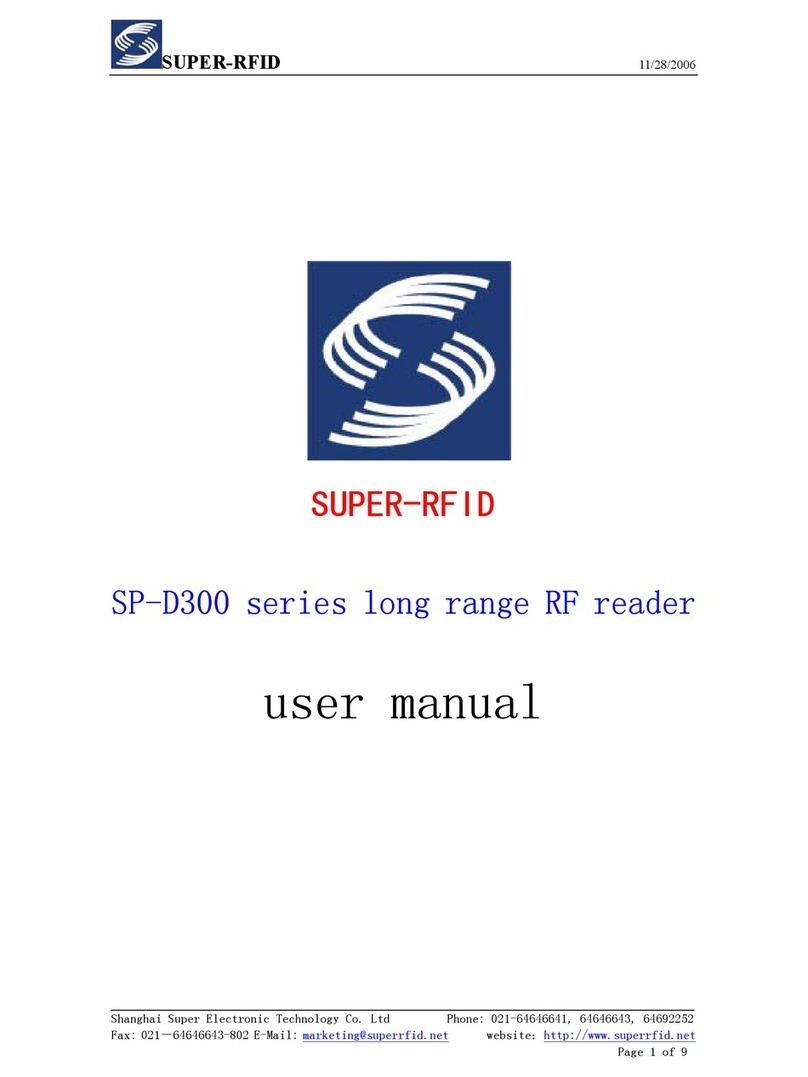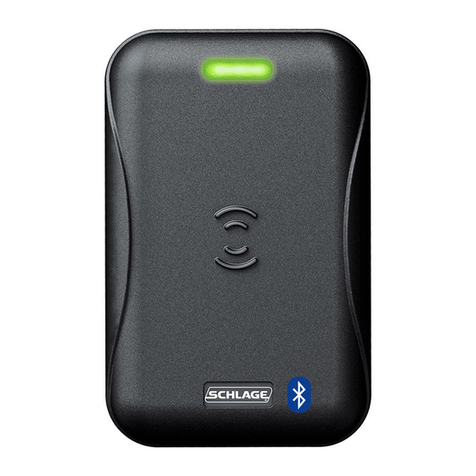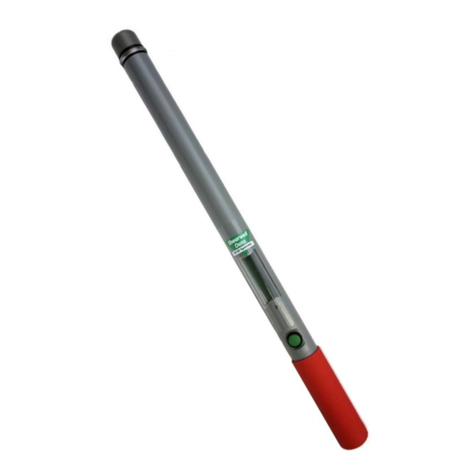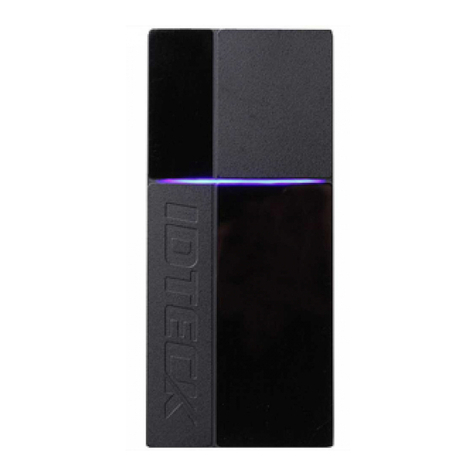NetworX NX-1700E Installation manual

NX1700EIE03
(Supercedes NX1700EID03)
NetworX Series™
NX-1700E Proximity Card Reader
Installation and Startup

NX-1700E Card Reader
2
© 2003 GE Interlogix
All rights reserved.
Printed in the United States of America.
These instructions do not purport to cover all details or variations in equipment nor to provide every possible
contingency to be met during installation, operation, and maintenance. If further information is desired or if particular
problems arise that are not covered sufficiently for the purchaser’s purpose, the matter should be referred to GE
Interlogix, Gladewater, Texas, USA.
This document contains proprietary information of GE Interlogix, USA and is furnished to its customer solely to assist
that customer in the installation, testing, operations, and/or maintenance of the equipment described. This document
shall not be reproduced in whole or in part nor shall its contents be disclosed to any third party without the written
approval of GE Interlogix.
Please refer to the current GE Interlogix product catalog for detailed warranty information.
Main 800-727-2339 Technical Support 800-727-2339
Outside the US 903-845-6941 Tech Support Fax 903-845-8409
Main Fax 903-845-6811 Sales & Literature 800-547-2556
Web: www.caddx.com
www.ge-interlogix.com
NetworX™is a trademark of the GE Interlogix companies.
Symbol Legend
Warning
Indicates a procedure, practice, condition, or statement that, if not strictly
observed, could result in personal injury.
* This symbol indicates electrical warnings and cautions.
Caution
Indicates a procedure, practice, condition, or statement that, if not strictly
observed, could result in damage to or destruction of equipment or property.
** This symbol indicates general warnings and cautions.
Note
Indicates an essential or important procedure, instruction, condition, or
statement.
Tip
Indicates a user tip. Provides helpful information that is not normally defined in
regular use, but from an experienced user.
Enter Indicates a key or button should be pressed to enter data.

NX-1700E Card Reader
3
TABLE OF CONTENTS
I. GENERAL DESCRIPTION...........................................................................................................................................4
II. INSTALLATION AND WIRING ..................................................................................................................................4
III. ENROLLING ...................................................................................................................................................................4
IV. ADDRESSING .................................................................................................................................................................5
V. PROGRAMMING...........................................................................................................................................................5
A. USING THE LED KEYPAD...................................................................................................................................5
Entering the Program Mode..............................................................................................................................................5
Entering the Module Address............................................................................................................................................5
Programming a Location ..................................................................................................................................................6
Exiting the Program Mode:...............................................................................................................................................6
B. USING THE LCD KEYPAD...................................................................................................................................7
C. PROGRAMMING DATA TYPES ..........................................................................................................................7
VI. USER CARDS..................................................................................................................................................................7
Adding One User...............................................................................................................................................................8
Adding Multiple Users with Auto-Increment.....................................................................................................................8
Activate One User (Single User).......................................................................................................................................9
De-Activate One User........................................................................................................................................................9
Delete / Reset One User ....................................................................................................................................................9
VII. PROGRAMMING LOCATIONS ................................................................................................................................10
Location 0 Programming the Scan Functions...............................................................................................10
Location 241 Programming the X-10 Address for the Scan Functions.............................................................10
Location 242 Programming the Options and Reader Partition........................................................................11
Location 243 Programming the Zones..............................................................................................................12
Location 244 Programming the Various Reader Timers ..................................................................................12
Location 245 Resetting the Reader Address......................................................................................................13
Location 246 Programming the Access Options...............................................................................................13
Location 247 Programming the Opening Time for Schedule 1.........................................................................13
Location 248 Programming the Closing Time for Schedule 1..........................................................................14
Location 249 Programming the Days for Schedule 1 .......................................................................................14
Locations 250 - 270 Programming the Schedules 2 - 8 ...............................................................................................14
Location 271 Programming the Date of Holidays in January..........................................................................14
Locations 272 - 282 Programming the Date of Holidays from February to December..............................................15
Location 283 Programming Activation Data for User Cards 1 through 120 ...................................................15
Location 284 Programming Activation Data for User Cards 121 through 240 ...............................................15
VIII. PROGRAMMING WORKSHEETS............................................................................................................................16
IX. ORDERING INFORMATION.....................................................................................................................................22
X. GLOSSARY....................................................................................................................................................................23
XI. FCC INFORMATION...................................................................................................................................................23
XII. UNDERWRITERS LABORATORIES INFORMATION.........................................................................................23
XIII. SPECIFICATIONS........................................................................................................................................................24

NX-1700E Card Reader
4
I. GENERAL DESCRIPTION
The NetworXNX-1700Eis a proximity cardreader/door control moduleusedto expandthecapabilities oftheNetworX
control panels.
$ Microprocessor-controlled
$ Includes one (1) low current trigger output, which can be used to control a door strike relay
$ Up to 15 card readers can be connected to the NetworX control panel
$ Can be programmed to control access in any or all partitions
$ LEDs can be programmed to follow the output and/or the armed or ready status of the system
$ Has an optional optical tamper switch
II. INSTALLATION AND WIRING
To install the card reader, simply wire it into the system. Refer to the following wiring table for details.
DESCRIPTION
GREEN
(DATA) Connect to the NetworX control panel DATA terminal. This wire is the data-
signaling
terminal to all the devices on the buss.
BLACK
(COM) Connect to the NetworX control panel COMMON
terminal. Supplies the commonsideof
the power to the card reader module.
RED
(POS) Connect to NetworX control panel AUX POWER +
terminal. Supplies power to the card
reader module.
WHITE
(EGRESS)
This is an optional EGRESS
(exit) input. To use this feature, connect the normally open
egress switch between this terminal and COM
. If this feature is not used, there is no
need to connect this wire.
BLUE
(OUTPUT)
This is an optional open-collector (negative trigger) OUTPUT
. It can be used to drive a
relay. To use this feature, connect the coil contacts of a relay between this terminal and
AUX POWER +. Absolute maximum 14 volts @ 25mA.
This is a low current output and must not
be used to directly energize high
current door openers.
III. ENROLLING
The NetworXcontrolpanelshave theabilitytoautomatically findandstore inmemorythe presence ofallkeypads, zone
expanders,wirelessreceivers, output modules,andanyother device onthekeypadbuss. This allows thesedevicesto
be supervised by the control panel. To enroll the devices, enter the Program Mode using the procedure outlined in the
control panel Installation Manual. When the Program Mode is exited, the NX-8 control will automatically enroll the
devices. Theenrollingprocesstakes about 12 seconds,duringwhichtime the ServiceLEDwillilluminate. User codes
will not be accepted during the enrolling process. Once a module is enrolled, if it is not detected by the control, the
Service LED will illuminate.

NX-1700E Card Reader 5
Scan: To
“present” or
pass a card or
FOB within
sensing range
of the card
reader module.
IV. ADDRESSING
Once the reader is wired into the system, the module needs to be addressed. Unlike most
NetworXexpanders,theaddress of anyparticularreader isdeterminedby itselfafterinstallation
is complete. Follow the procedures outlined under the section “PROGRAMMING”. When
prompted to enter the module device number, a card must be scanned at the reader to initiate
addressing (one short beep). When completed (1-2 seconds), the reader will beep back its
address (long beeps). Refer to Table IV-1 that follows for possible addresses.
Table IV-1
Beeps Address Beeps Address
1 113 9 121
2 114 10 122
3 115 11 123
4 116 12 124
5 117 13 125
6 118 14 126
7 119 15 127
8 120
V. PROGRAMMING
A. USING THE LED KEYPAD
ACTION RESULT
ENTERING THE PROGRAM MODE
Enters the Program Mode.
Stay, Chime, Exit, Bypass & Cancel LEDS will
flash.
[Go To Program Code]
Factory Default is
If the "Go To Program Code" is valid, the "Service"
LED will flash and the 5 function LEDs will
illuminate steady. You are now in the Program
Mode and ready to select the module address.
ENTERING THE MODULE ADDRESS
Scan a card.
The card reader will address itself.
#
(example only)
Enters the module address. Refer to Table IV-1 on
page5forthe address assigned bythecardreader
module itself.
The Armed LED will illuminate while it is waiting for
a programming location to be entered.

NX-1700E Card Reader
6
PROGRAMMING A LOCATION
If an attempt is made to program an invalid entry for a particular segment, the keypad
sounder will emit a triple error beep (beep, beep, beep), and remain in that segment
awaiting a valid entry.
To Enter a Location:
[location] #
The Armed LED will flash. If the location is valid,
the "Armed" LED will extinguish, the "Ready" LED
will illuminate, and the zone LED’s will show the
data for the first segment of this location.
To Change Location Data:
[changed data]
The "Ready" LED will flash to indicate a data
changeinprocessand will continueuntilthedatais
saved.
The new data is saved.
The keypad will increment and display the next
segment’s data.
NOTE: Repeat these steps until the last
segment is reached.
To Exit a Location:
#
Exits from this location. The “Ready” LED will
extinguish.The"Armed"LED will illuminatewaiting
for a new programming location to be entered.
To Review The Data:
[location] #
The Armed LED will flash. If the location is valid,
the "Armed" LED will extinguish, the "Ready" LED
will illuminate, and the zone LED’s will show the
data for the first segment of this location.
(Do not enter data.)
The next segment is displayed. Each time ris
pressed, the data of the next segment will be
displayed for review.
Shortcuts:
Previous location.
Same location.
Next sequential location.
EXITING THE PROGRAM MODE:
EXIT EXIT
Exits this programming level.

NX-1700E Card Reader 7
B. USING THE LCD KEYPAD
All steps required for programming are the same as the aforementioned LED keypad. The LCD keypad display will
prompt you for the data required. While in the programming mode, and not in a location, the number in parenthesis is
thelocationyouwere previously changing. For example,ifthe displayreads"Enterlocation,then # (5)",itis reminding
you that location 5 was the last location you programmed. In feature selection data, the numbers of the enabled
features will be displayed. The features not enabled will display a hyphen (-).
C. PROGRAMMING DATA TYPES
a) Numerical Data
Numerical data can take on values from 0-255 or 0-15 depending on the segment size.
b) Feature Selection
Feature selection data is used to turn features on or off.
VI. USER CARDS
Addingandde-activating usersisdone through acombinationof enteringinformationat the keypadand scanningcards.
Before a card can be entered, one reader on the system must be programmed with User Card Programming enabled
(Location 242, Segment 1, Option 1, page 11).
It is recommended that only one reader on the system be enabled to modify user cards and that
this reader be located near a keypad. This reader will transfer information toall other readers in
the system once programming is finished.
Once a reader is enabled to modify users, it must be placed into one of the following five modes:
1) Add One User
2) Add Multiple Users w/ Auto-Increment
3) Activate One User
4) De-Activate One User
5) Delete/Reset One User.
Modifying users on a card reader is similar to modifying user codes at a keypad.
MUST BE A MASTER USER IN ORDER TO MODIFY USER CARD INFORMATION.
ACTION RESULT
Accesses Code Programming
[master code]
Factory Default is
If the code is valid, the Ready LED will flash.
User Number 2 isused to program usercards, so…
if the control is an NX-4, NX-6,
or NX-8
if the control is an NX-8E
Unit is now ready for you to choose one of the User
Card Programming modes (as if user code 2):
1) Add One User
2) Add Multiple Users (w/ Auto-Increment)
3) Activate Single User
4) De-activate One User
5) Delete / Reset One User
IMPORTANT NOTE
Adding or de-activating user cards from a reader will cause the code for User Number 2 to become invalid.
Therefore, it will need to be re-entered after all user cards are programmed into the readers.

NX-1700E Card Reader
8
ADDING ONE USER
ACTION RESULT
[STAY]
Accesses Activation mode
[3-digit user number]
Example: if 4-digit user code
or if 6-digit user codes
If a valid user number is entered, LED1 on any
enabled readers will begin to flash.
Scan the card designated for the user
entered in the previous step.
1) If the user card is not already in the system, it
will be added and mapped to the entered user
number and LED1 will continue flashing
indicating that the next user card can be
scanned for the next user number.
2) If the card is already in the system, the reader
willtriplebeepand LED1 will continueflashing;
the user number is not incremented in this
case.
Continue scanning user cards until the
desired number of cards has been added.
After about 30 seconds without a card being
scanned, all the readers in the system will be
updated with the new user card information.
ADDING MULTIPLE USERS WITH AUTO-INCREMENT
ACTION RESULT
[CANCEL]
Accesses Activation mode
[3-digit user number]
Example: if 4-digit user code
or if 6-digit user codes
If a valid user number is entered, LED1 on any
enabled readers will begin to flash.
Scan the card designated for the user
entered in the previous step.
3) If the user card is not already in the system, it
will be added and mapped to the entered user
number and LED1 will continue flashing
indicating that the next user card can be
scanned for the next user number.
4) If the card is already in the system, the reader
willtriplebeepand LED1 will continueflashing;
the user number is not incremented in this
case.
Continue scanning user cards until the
desired number of cards has been added.
After about 30 seconds without a card being
scanned, all the readers in the system will be
updated with the new user card information.
By default, user cards are added and activated. In order to add a user card and
de-activate it at the same time, scan and hold the card to be added until two
beeps are sounded at the reader.

NX-1700E Card Reader 9
ACTIVATE ONE USER (SINGLE USER)
ACTION RESULT
[CHIME]
Accesses Activation mode
[3-digit user number]
Example: if 4-digit user code
or if 6-digit user codes
If a valid user number is entered, LED1 on any
enabled readers will begin to flash.
Scan any card.
The card information for the user entered in the
previous step will be activated, and LED1 will stop
flashing. After about 30 seconds, all the readers in
the system will be updated.
DE-ACTIVATE ONE USER
ACTION RESULT
[BYPASS]
Accesses De-activation mode
[3-digit user number]
Example: if 4-digit user code
or if 6-digit user codes
If a valid user number is entered, LED1 on any
enabled readers will begin to flash.
Scan any card
The card information for the user entered in the
previous step will be cleared, and LED1 will stop
flashing. After about 30 seconds, all the readers in
the system will be updated.
DELETE / RESET ONE USER
ACTION RESULT
[EXIT]
Accesses De-activation mode
[3-digit user number]
Example: if 4-digit user code
or if 6-digit user codes
If a valid user number is entered, LED1 on any
enabled readers will begin to flash.
Scan any card
The card information for the user entered in the
previous step will be cleared, and LED1 will stop
flashing. After about 30 seconds, all the readers in
the system will be updated.
If an individual keeps the
card, it can still be deleted.
ACTIVATING / DE-ACTIVATING / RESETTING USERS
If User Number 0 is entered, the desired function will be performed on the
user associated with the card scanned.

NX-1700E Card Reader
10
VII. PROGRAMMING LOCATIONS
SCAN METHODS: Legacy mode is default. Alternative mode is shown below in brackets { }.
Refer to Location 242 Segment 1 on page 11, and the Glossary on page 23 for explanation.
LOCATION 0 PROGRAMMING THE SCAN FUNCTIONS
(3 segments of binary data) Location 0 is used to select the particular function(s) that are activated when a card is
scanned.Morethanone function may beselected.Ifmore than onefunctionisselected, they will executeinorderfrom
function 1 to function 8.
Functions 1-6 will be performed based on the user’s authority as programmed by the [] [6] function
(refer to keypad user manual).
Segment 1 Single Scan Function {Single Beep}
Program the functions that are performed when a card is scanned {one beep}.
LED1 - "On" to send Code Entry function to the control panel.
LED2 - "On" to activate the Armed Away mode.
LED3 - "On" to activate the Armed Stay mode.
LED4 - "On" to send the Disarm function to the control panel.
LED5 - "On" to send Auxiliary Function #1 to the control panel.
LED6 - "On" to send Auxiliary Function #2 to the control panel.
LED7 - "On" to broadcast an X-10 function (see Location 241 for programming).
LED8 - "On" to send a Request To Exit (RTE); and activate the onboard open collector output.
(Default is “On”) Location 243, Segment 2 must be programmed with a valid zone number
for the RTE to be sent.
Segment 2 Double Scan Function {Double Beep}
Program the functions that are performed when a card is scanned twice within the 2 Scan Hold Time {two beeps}.
Location 244, Segment 1 programs the length of time between beeps. The descriptions of the options are the same as
for Single Beep Scan Function. Default is 1.
Segment 3 Single Scan Hold Function {Triple Beep}
Program the functions that are performed when a card is scanned and held at the reader for the duration of the 2Scan
HoldTime{threebeeps}. Location 244,Segment1 programs thelengthof timebetweenbeeps. Thedescriptionsof the
options are the same as for Single Beep Scan Function. Default is 1.
LOCATIONS 1 - 240 RESERVED
LOCATION 241 PROGRAMMING THE X-10 ADDRESS FOR THE SCAN FUNCTIONS
(5 segments of numerical data)
Segment 1
Program a number from 0 -15 to represent the corresponding X-10 Module Number from the following table.
Default is 0.
Module
1
2
3
4
5
6
7
8
9
10
11
12
13
14
15
16
Seg 1 0
1
2
3
4
5
6
7
8
9
10
11
12
13
14
15

NX-1700E Card Reader 11
Segment 2 Program a number from 0-15 to represent the corresponding X-10 House code from the following
table. Default is 0.
X-10 ADDRESS CODES
0=A 4=E 8=I 12=M
1=B 5=F 9=J 13=N
2=C 6=G 10=K 14=O
3=D 7=H 11=L 15=P
Segment 3 Single Scan Function {Single Beep}
Program the X-10 function that is performed when a card is scanned {one beep}. This location only needs to be
programmed if Location 0, Segment 1, Option 7 is set. Use the following table. Default is 2.
Function # Function performed Function # Function performed
0 All units off 4 Dim
1 All lights on 5 Bright
2 On 6 All lights off
3 Off All others Reserved
Segment 4 Double Scan Function {Double Beep}
Program the X-10 function that is performed when a card is scanned twice within the 2 Scan Hold Time {two beeps}.
Location 244, Segment 1 programs the length of time between beeps. The descriptions of the function codes are the
sameasforSingle Beep Scan Function.Thislocationonly needs tobeprogrammedif Location0,Segment2, Option7
is set. Use the above table. Default is 3.
Segment 5 Single Scan Hold Function {Triple Beep}
Program the X-10 function that is performed when a card is scanned and held at the reader for the duration of the 2
Scan Hold Time {three beeps}. Location 244, Segment 1 programs the length of time between beeps. The
descriptions of the function codes are the same as for Single Beep Scan Function. This location only needs to be
programmed if Location 0, Segment 3, Option 7 is set. Use the above table. Default is 2.
LOCATION 242 PROGRAMMING THE OPTIONS AND READER PARTITION
(4 segments of binary data)
Segment 1 System Options:
LED1 - "On" if reader is enabled for User Card Programming.
LED2 - "On" if optical tamper is enabled.
LED3 - "On" if reader buzzer is to follow typical keypad buzzing. (Default is “On”)
LED4 - "On" if ding-dong chime enabled (dependent on both Option 3 and chime being enabled).
LED5 - “On” if an RTE from a scanned card is to be logged as Code Entry. (Default is “On”)
LED6 - “On” if reader is in NX-1700E Legacy Mode (Default is “On”) Refer to note below.
LED7 - “On” if an RTE) from a zone or the Egress input is to be logged as Code Entry.
LED8 - Reserved.
The card reader is defaulted to the “Legacy mode”. This mode uses the same scan method as
previous NX-1700E card readers. However, an alternative scan method is availablebyturning
off LED6 in Location 242, Segment 1. Rather than passing the card (scan) within range of the
card reader, the card can be held at the reader for a specified number of beeps.
Example of Double Scan: Legacy mode -- Pass the card by the reader’s sensor, remove it from
the sensor area, then pass the card bythe reader’s sensor once again. Alternativemode -- Hold
the card at the card reader for a total of 2 beeps. Refer also to the Glossary on page 24.
IMPORTANT: If you have older models installed in the system without this enhanced feature, it
could result in two different methods of scanning at various readers.

NX-1700E Card Reader
12
Segment 2 LED1 (Green) Options:
LED1 - "On" to follow Ready status of system. (Default is “On”)
LED2 - "On" to toggle with the open collector output activation. (Default is “On”)
LED3 - "On" if inverted.
LED4 - Reserved.
LED5 - Reserved.
LED6 - Reserved.
LED7 - Reserved.
LED8 - Reserved.
Segment 3 LED2 (Red) Options:
LED1 - "On" to follow Armed status of system. (Default is “On”)
LED2 - "On" to toggle with the open collector output activation.
LED3 - "On" if inverted.
LED4 - Reserved.
LED5 - Reserved.
LED6 - Reserved.
LED7 - Reserved.
LED8 - Reserved.
Segment 4 Reader Partition:
LED1 - "On" if reader is in Partition 1. (Default is “On”)
LED2 - "On" if reader is in Partition 2. (Default is “On”)
LED3 - "On" if reader is in Partition 3. (Default is “On”)
LED4 - "On" if reader is in Partition 4. (Default is “On”)
LED5 - "On" if reader is in Partition 5. (Default is “On”)
LED6 - "On" if reader is in Partition 6. (Default is “On”)
LED7 - "On" if reader is in Partition 7. (Default is “On”)
LED8 - "On" if reader is in Partition 8. (Default is “On”)
LOCATION 243 PROGRAMMING THE ZONES
(2 segments of numerical data)
Segment 1 Door Shunt Zone
Program the zone that will be monitored as a door for access control. This location must be programmed with a valid
zone for monitored access control functions to work properly. (Default is 0)
Additionally, this zone must be configured in the control panel as a Door Shunt zone by programming an
unused Zone Type Characteristic in locations 111-169 (Seg 4, Opt 4).
Segment 2 Request To Exit (RTE) Zone
Program the zone that will be monitored to signal an RTE. If this segment is programmed with a valid zone and the
zone is faulted, the reader will activate its onboard open collector output and send the RTE. (Default is 0)
Additionally, this zone must be configured in the control panel as an RTE zone by programming an unused
Zone Type Characteristic in locations 111-169 (Seg 4, Opt 3).
LOCATION 244 PROGRAMMING THE VARIOUS READER TIMERS
(4 segment of numerical data)
Segment 1 Scan Time
Enter the amount of time required to hold a card between beeps to activate the functions programmed in Location 0,
Segments 2 and 3.This timer is timed in1/100-second increments from 0 to 2.55seconds. (Default is 100 = 1second).
Segment 2 Relay Active Time
Entertheamountof time the onboardopencollectoroutput is energized onceactivated.Thistimer istimedin 1-second
increments from 0 to 255 seconds. (Default is 10 = 10 seconds).

NX-1700E Card Reader 13
Segment 3 Door Fault Warning Time
Enter the amount of time a monitored zone (see Location 243, Segment 1) must be faulted before sounding a warning
(local buzzer). The door fault warning is timed in 1-second increments from 0 to 255 seconds. (Default is 30 = 30
seconds).
Segment 4 Door Fault Alarm Time
Enter the amount of time a monitored zone (see Location 243, Segment 1) must be faulted before sending an alarm
conditiontothecontrol panel. The doorfaultalarmis timed in1-secondincrementsfrom 0 to 255seconds.(Defaultis0
= disabled).
LOCATION 245 RESETTING THE READER ADDRESS
(1 segment of numerical data) If it is necessary to reset the address of the reader, enter a 0 in this location.
This will cause the reader to cease functioning.Ifacard isscannedwith thesystemin ProgramMode,
the reader will again find an available address and set itself, beeping back to the user the address that
was found as per the table on page 5. If the system is not in Program Mode and a card is scanned at a
reader with a reset address, then it will sound an error beep.
LOCATION 246 PROGRAMMING THE ACCESS OPTIONS
(2 segments of binary data)
Segment 1 Door Options
LED1 - "On" if locking mechanism is a Maglock or Drop Bolt.
LED2 - "On" if access is allowed regardless of Armed status of the system.
LED3 - "On" if the door is not to be latched unlocked during an open schedule.
LED4 - "On" if onboard open collector output only triggers during an open schedule.
LED5 - “On” if onboard open collector output only triggers during a close schedule.
LED6 - “On” if Forced Entry Alarm is logged.
LED7 - “On” if access allowed without an RTE. (Default is “On”)
LED8 - Reserved.
Segment 2 Enabling the Schedules for the Onboard Open Collector Output:
LED1 - "On" if driver follows Schedule 1.
LED2 - "On" if driver follows Schedule 2.
LED3 - "On" if driver follows Schedule 3.
LED4 - "On" if driver follows Schedule 4.
LED5 - "On" if driver follows Schedule 5.
LED6 - "On" if driver follows Schedule 6.
LED7 - "On" if driver follows Schedule 7.
LED8 - "On" if driver follows Schedule 8.
LOCATION 247 PROGRAMMING THE OPENING TIME FOR SCHEDULE 1
(2 segments of numerical data)
Segment 1 Program the hour of the opening time in 24-hour format. (Default is 8= 8:00 AM)
Segment 2 Program the minutes after the hour of the opening time for Schedule 1. (Default is 0)

NX-1700E Card Reader
14
LOCATION 248 PROGRAMMING THE CLOSING TIME FOR SCHEDULE 1
(2 segments of numerical data)
Segment 1 Program the hour of the closing time in 24-hour format. (Default is 20 = 8:00 PM)
Segment 2 Program the minutes after the hour of the closing time for Schedule 1. (Default is 0)
LOCATION 249 PROGRAMMING THE DAYS FOR SCHEDULE 1
(1 segment of binary data)
LED1 = "On" if schedule is active on Sunday.
LED2 = "On" if schedule is active on Monday.
LED3 = "On" if schedule is active on Tuesday.
LED4 = "On" if schedule is active on Wednesday.
LED5 = “On” if schedule is active on Thursday.
LED6 = “On” if schedule is active on Friday.
LED7 = “On” if schedule is active on Saturday.
LED8 = “On” if schedule is disabled on holidays.
LOCATIONS 250 - 270 PROGRAMMING THE SCHEDULES 2 - 8
Locations250-270 are used toprogramtheopening times,closingtimes, anddaysfor Schedules2- 8. Eachschedule
hasthreelocationsthat are programmed withthesamesteps as Schedule1describedpreviously. RefertoSchedule 1
(Locations 247 - 249 above) for specific instructions.
Location 250 – Opening Time for Schedule 2 Location 262 – Opening Time for Schedule 6
Location 251 – Closing Time for Schedule 2 Location 263 – Closing Time for Schedule 6
Location 252 – Days for Schedule 2 Location 264 – Days for Schedule 6
Location 253 – Opening Time for Schedule 3 Location 265 – Opening Time for Schedule 7
Location 254 – Closing Time for Schedule 3 Location 266 – Closing Time for Schedule 7
Location 255 – Days for Schedule 3 Location 267 – Days for Schedule 7
Location 256 – Opening Time for Schedule 4 Location 268 – Opening Time for Schedule 8
Location 257 – Closing Time for Schedule 4 Location 269 – Closing Time for Schedule 8
Location 258 – Days for Schedule 4 Location 270 – Days for Schedule 8
Location 259 – Opening Time for Schedule 5
Location 260 – Closing Time for Schedule 5
Location 261 – Days for Schedule 5
LOCATION 271 PROGRAMMING THE DATE OF HOLIDAYS IN JANUARY
(8 segments of numerical data) Program the day of the month in January that the Opening time in a schedule is
suppressed. For example, if the opening should not occur on January 1, program a “1” in Segment 1. This feature can
be repeated up to a maximum of 8 holidays per location (month). (Default is No holidays)

NX-1700E Card Reader 15
LOCATIONS 272 - 282 PROGRAMMING THE DATE OF HOLIDAYS FROM FEBRUARY TO DECEMBER
(8 segments of numerical data) Locations 272 - 282 are used to program the day of each month, from February to
December, in which the Opening time in a schedule is suppressed. Each location will accommodate up toa maximum
of 8 holidays, and programmed with the same steps as Location 271 described previously.
Location 272 – February holidays
Location 273 – March holidays
Location 274 – April holidays
Location 275 – May holidays
Location 276 – June holidays
Location 277 – July holidays
Location 278 – August holidays
Location 279 – September holidays
Location 280 – October holidays
Location 281 – November holidays
Location 282 – December holidays
LOCATION 283 PROGRAMMING ACTIVATION DATA FOR USER CARDS 1 THROUGH 120
(15 segments of binary data)
This location is used to select which user cards 1 through 120 are activated. If the LEDis “on”, the card is active. Each
segmenthas8LEDs corresponding to the8possibleuser cards. Example: Segment 4,LED2indicatesthatusercard
26 is active.
Segment 1 User Cards 1 - 8 Segment 9 User Cards 65 - 72
Segment 2 User Cards 9 - 16 Segment 10 User Cards 73 - 80
Segment 3 User Cards 17 - 24 Segment 11 User Cards 81 - 88
Segment 4 User Cards 25 - 32 Segment 12 User Cards 89 - 96
Segment 5 User Cards 33 - 40 Segment 13 User Cards 97 - 104
Segment 6 User Cards 41 - 48 Segment 14 User Cards 105 - 112
Segment 7 User Cards 49 - 56 Segment 15 User Cards 113 - 120
Segment 8 User Cards 57 - 64
LOCATION 284 PROGRAMMING ACTIVATION DATA FOR USER CARDS 121 THROUGH 240
(15 segments of binary data)
This location is used to select which user cards 121 through 240 are activated. If the LED is “on”, the card is active.
Each segment has 8 LEDs corresponding to the 8 possible user cards. Example: Segment 15, LED 8 indicates that
user card 240 is active.
Segment 1 User Cards 121 - 128 Segment 9 User Cards 185 - 192
Segment 2 User Cards 129 - 136 Segment 10 User Cards 193 - 200
Segment 3 User Cards 137 - 144 Segment 11 User Cards 201 - 208
Segment 4 User Cards 145 - 152 Segment 12 User Cards 209 - 216
Segment 5 User Cards 153 - 160 Segment 13 User Cards 217 - 224
Segment 6 User Cards 161 - 168 Segment 14 User Cards 225 - 232
Segment 7 User Cards 169 – 176 Segment 15 User Cards 233 - 240
Segment 8 User Cards 177 - 184
LED1 = Card 1
LED2 = Card 2
LED3 = Card 3
LED4 = Card 4
LED5 = Card 5
LED6 = Card 6
LED7 = Card 7
LED8 = Card 8
LED1 = Card 1
LED2 = Card 2
LED3 = Card 3
LED4 = Card 4
LED5 = Card 5
LED6 = Card 6
LED7 = Card 7
LED8 = Card 8

NX-1700E Card Reader
16
IMPORTANT TIP:
Defaults are shown in
bold italics.
VIII. PROGRAMMING WORKSHEETS
LOC PG DESCRIPTION DEFAULT YOUR DATA
0 10 SCAN FUNCTIONS
Seg 1 SINGLE SCAN FUNCTION (1 Beep) 8
1 = "On" to send Code Entry function to the control panel.
2 = "On" to activate the Armed Away mode.
3 = "On" to activate the Armed Stay mode.
4 = "On" to send the Disarm function to the control panel.
5 = "On" to send Auxiliary Function #1 to the control panel.
6 = "On" to send Auxiliary Function #2 to the control panel.
7 = "On" to broadcast an X-10 function (Loc 241 for programming).
8 = "On" to send an RTE; and activate the onboard open collector output.
Seg 2 DOUBLE SCAN FUNCTION (2 Beep) 1
1 = "On" to send Code Entry function to the control panel.
2 = "On" to activate the Armed Away mode.
3 = "On" to activate the Armed Stay mode.
4 = "On" to send the Disarm function to the control panel.
5 = "On" to send Auxiliary Function #1 to the control panel.
6 = "On" to send Auxiliary Function #2 to the control panel.
7 = "On" to broadcast an X-10 function (Loc 241 for programming).
8 = "On" to send an RTE; and activate the onboard open collector output.
Seg 3 SINGLE SCAN HOLD FUNCTION (3 Beep)
1
1 = "On" to send Code Entry function to the control panel.
2 = "On" to activate the Armed Away mode.
3 = "On" to activate the Armed Stay mode.
4 = "On" to send the Disarm function to the control panel.
5 = "On" to send Auxiliary Function #1 to the control panel.
6 = "On" to send Auxiliary Function #2 to the control panel.
7 = "On" to broadcast an X-10 function (Loc 241 for programming).
8 = "On" to send an RTE; and activate the onboard open collector output.
1-240 10 RESERVED
241 10 X-10 ADDRESS
Seg 1 MODULE NUMBER 0
Seg 2 HOUSE CODE 0
(see chart)
Seg 3 SINGLE SCAN FUNCTION (1Beep) 2
0 = All units off
1 = All lights on
2 = On
3 = Off
4 = Dim
5 = Bright
6 = All lights off
X-10 ADDRESS CODES
0=A 4=E 8=I 12=M
1=B 5=F 9=J 13=N
2=C 6=G 10=K
14=O
3=D 7=H 11=L
15=P

NX-1700E Card Reader 17
LOC PG DESCRIPTION DEFAULT YOUR DATA
241 10 Seg 4 DOUBLE SCAN FUNCTION (2 Beep) 3
0 = All units off
1 = All lights on
2 = On
3 = Off
4 = Dim
5 = Bright
6 = All lights off
Seg 5 SINGLE SCAN HOLD FUNCTION (3 Beep)
2
0 = All units off
1 = All lights on
2 = On
3 = Off
4 = Dim
5 = Bright
6 = All lights off
242 11 OPTIONS AND READER PARTITION
Seg 1 SYSTEM OPTIONS 3, 5, 6
1 = "On" if enabled for User Card Programming
2 = "On" if optical tamper enabled
3 = "On" if buzzer follows keypad buzzing
4 = "On" if ding-dong chime enabled (Opt 3 & chime must be enabled)
5 = “On” if an RTE from a scanned card is to be logged as Code Entry
6 = “On” if reader is in NX-1700E Legacy Mode
7 = “On” if an RTE from a zone or the Egress input is to be logged as Code Entry.
8 = Reserved
Seg 2 LED1 (GREEN) OPTIONS 1,2
1 = "On" follows system Ready status
2 = "On" to toggle with the Open Collector output
3 = "On" if inverted
4 = Reserved
5 = Reserved
6 = Reserved
7 = Reserved
8 = Reserved
Seg 3 LED2 (RED) OPTIONS 1
1 = "On" follows system Armed status
2 = "On" to toggle with the Open Collector output
3 = "On" if inverted
4 = Reserved
5 = Reserved
6 = Reserved
7 = Reserved
8 = Reserved

NX-1700E Card Reader
18
LOC PG DESCRIPTION DEFAULT YOUR DATA
242 11 Seg 4 READER PARTITION 1,2,3,4,5,6,7,8
1 = "On" if reader is in Partition 1
2 = "On" if reader is in Partition 2
3 = "On" if reader is in Partition 3
4 = "On" if reader is in Partition 4
5 = "On" if reader is in Partition 5
6 = "On" if reader is in Partition 6
7 = "On" if reader is in Partition 7
8 = "On" if reader is in Partition 8
243 12 PROGRAMMING THE ZONES
Seg 1 Door Shunt Zone 0 = Disabled
Seg 2 Request To Exit (RTE) 0 = Disabled
244 12 READER TIMES
Seg 1 Scan Time (1/100 seconds) 100 = 1 second
Seg 2 Relay Active Time (seconds) 10 = 10 seconds
Seg 3 Door Fault Warning Time (seconds) 30 = 30 seconds
Seg 4 Door Fault Alarm Time (seconds) 0 = Disabled
245 13 RESET THE READER ADDRESS
Entering a “0” will reset and cause the reader to
cease functioning.
000000000000000000000000000000000000000000000000000000000000000000000000000000000000000000000000000000000000000000000000000000000000000000000000000000000000000000000000000000000
0
000000000000000000000000000000000000000000000000000000000000000000000000000000000000000000000000000000000000000000000000000000000000000000000000000000000000000000000000000
00000
0
000000000000000000000000000000000000000000000000000000000000000000000000000000000000000000000000000000000000000000000000000000000000000000000000000000000000000000000000000
00000
0
000000000000000000000000000000000000000000000000000000000000000000000000000000000000000000000000000000000000000000000000000000000000000000000000000000000000000000000000000
00000
0
000000000000000000000000000000000000000000000000000000000000000000000000000000000000000000000000000000000000000000000000000000000000000000000000000000000000000000000000000
00000
000000000000000000000000000000000000000000000000000000000000000000000000000000000000000000000000000000000000000000000000000000000000000000000000000000000000000000000000000000000
00000000000000000000000000000000000000000000000000000000000000000000000000000000000000000000000000000000000000000000000000000000000000000000000000000000000000000000000000000000000000000000000000000000
00000000000000000000000000000000000000000000000000000000000000000000000000000000000000000000000000000000000000000000000000000000000000000000000000000000000000000000000000000000000000000000000000000000
00000000000000000000000000000000000000000000000000000000000000000000000000000000000000000000000000000000000000000000000000000000000000000000000000000000000000000000000000000000000000000000000000000000
00000000000000000000000000000000000000000000000000000000000000000000000000000000000000000000000000000000000000000000000000000000000000000000000000000000000000000000000000000000000000000000000000000000
00000000000000000000000000000000000000000000000000000000000000000000000000000000000000000000000000000000000000000000000000000000000000000000000000000000000000000000000000000000000000000000000000000000
00000000000000000000000000000000000000000000000000000000000000000000000000000000000000000000000000000000000000000000000000000000000000000000000000000000000000000000000000000000000000000000000000000000
00000000000000000000000000000000000000000000000000000000000000000000000000000000000000000000000000000000000000000000000000000000000000000000000000000000000000000000000000000000000000000000000000000000
00000000000000000000000000000000000000000000000000000000000000000000000000000000000000000000000000000000000000000000000000000000000000000000000000000000000000000000000000000000000000000000000000000000
00000000000000000000000000000000000000000000000000000000000000000000000000000000000000000000000000000000000000000000000000000000000000000000000000000000000000000000000000000000000000000000000000000000
00000000000000000000000000000000000000000000000000000000000000000000000000000000000000000000000000000000000000000000000000000000000000000000000000000000000000000000000000000000000000000000000000000000
00000000000000000000000000000000000000000000000000000000000000000000000000000000000000000000000000000000000000000000000000000000000000000000000000000000000000000000000000000000000000000000000000000000
00000000000000000000000000000000000000000000000000000000000000000000000000000000000000000000000000000000000000000000000000000000000000000000000000000000000000000000000000000000000000000000000000000000
00000000000000000000000000000000000000000000000000000000000000000000000000000000000000000000000000000000000000000000000000000000000000000000000000000000000000000000000000000000000000000000000000000000
00000000000000000000000000000000000000000000000000000000000000000000000000000000000000000000000000000000000000000000000000000000000000000000000000000000000000000000000000000000000000000000000000000000
00000000000000000000000000000000000000000000000000000000000000000000000000000000000000000000000000000000000000000000000000000000000000000000000000000000000000000000000000000000000000000000000000000000
000000000000000000000000000000000000000000000000000000000000000000000000000000000000000000000000000000000000000000000000000000000000000000000000000000000000000000000000000000000000000000000000000000000000000
0
000000000000000000000000000000000000000000000000000000000000000000000000000000000000000000000000000000000000000000000000000000000000000000000000000000000000000000000000000000000000000000000000000000000
00000
0
000000000000000000000000000000000000000000000000000000000000000000000000000000000000000000000000000000000000000000000000000000000000000000000000000000000000000000000000000000000000000000000000000000000
00000
0
000000000000000000000000000000000000000000000000000000000000000000000000000000000000000000000000000000000000000000000000000000000000000000000000000000000000000000000000000000000000000000000000000000000
00000
000000000000000000000000000000000000000000000000000000000000000000000000000000000000000000000000000000000000000000000000000000000000000000000000000000000000000000000000000000000000000000000000000000000000000
00000000000000000000000000000000000000000000000000000000000000000000000000000000000000000000000000000000000000000000000000000000000000000000000000000000000000000000000000000000000000000000000000000000000000000000000000000000000000
00000000000000000000000000000000000000000000000000000000000000000000000000000000000000000000000000000000000000000000000000000000000000000000000000000000000000000000000000000000000000000000000000000000000000000000000000000000000000
00000000000000000000000000000000000000000000000000000000000000000000000000000000000000000000000000000000000000000000000000000000000000000000000000000000000000000000000000000000000000000000000000000000000000000000000000000000000000
00000000000000000000000000000000000000000000000000000000000000000000000000000000000000000000000000000000000000000000000000000000000000000000000000000000000000000000000000000000000000000000000000000000000000000000000000000000000000
00000000000000000000000000000000000000000000000000000000000000000000000000000000000000000000000000000000000000000000000000000000000000000000000000000000000000000000000000000000000000000000000000000000000000000000000000000000000000
00000000000000000000000000000000000000000000000000000000000000000000000000000000000000000000000000000000000000000000000000000000000000000000000000000000000000000000000000000000000000000000000000000000000000000000000000000000000000
00000000000000000000000000000000000000000000000000000000000000000000000000000000000000000000000000000000000000000000000000000000000000000000000000000000000000000000000000000000000000000000000000000000000000000000000000000000000000
00000000000000000000000000000000000000000000000000000000000000000000000000000000000000000000000000000000000000000000000000000000000000000000000000000000000000000000000000000000000000000000000000000000000000000000000000000000000000
00000000000000000000000000000000000000000000000000000000000000000000000000000000000000000000000000000000000000000000000000000000000000000000000000000000000000000000000000000000000000000000000000000000000000000000000000000000000000
00000000000000000000000000000000000000000000000000000000000000000000000000000000000000000000000000000000000000000000000000000000000000000000000000000000000000000000000000000000000000000000000000000000000000000000000000000000000000
00000000000000000000000000000000000000000000000000000000000000000000000000000000000000000000000000000000000000000000000000000000000000000000000000000000000000000000000000000000000000000000000000000000000000000000000000000000000000
00000000000000000000000000000000000000000000000000000000000000000000000000000000000000000000000000000000000000000000000000000000000000000000000000000000000000000000000000000000000000000000000000000000000000000000000000000000000000
00000000000000000000000000000000000000000000000000000000000000000000000000000000000000000000000000000000000000000000000000000000000000000000000000000000000000000000000000000000000000000000000000000000000000000000000000000000000000
00000000000000000000000000000000000000000000000000000000000000000000000000000000000000000000000000000000000000000000000000000000000000000000000000000000000000000000000000000000000000000000000000000000000000000000000000000000000000
00000000000000000000000000000000000000000000000000000000000000000000000000000000000000000000000000000000000000000000000000000000000000000000000000000000000000000000000000000000000000000000000000000000000000000000000000000000000000
00000000000000000000000000000000000000000000000000000000000000000000000000000000000000000000000000000000000000000000000000000000000000000000000000000000000000000000000000000000000000000000000000000000
00000000000000000000000000000000000000000000000000000000000000000000000000000000000000000000000000000000000000000000000000000000000000000000000000000000000000000000000000000000000000000000000000000000000000000000000000000000000000
246 13 PROGRAMMING THE ACCESS OPTIONS
Seg 1 DOOR OPTIONS
1 = "On" if locking mechanism is a Maglock or Drop Bolt.
2 = "On" if access is allowed regardless of Armed status of the system.
3 = "On" if the door is not to be latched unlocked during an open schedule.
4 = "On" if onboard open collector output only triggers during an open schedule.
5 = “On” if onboard open collector output only triggers during a close schedule.
6 = “On” if Forced Entry Alarm is logged.
7 = “On” if access allowed without an RTE.
8 = Reserved.
Seg 2 SCHEDULES FOR ONBOARD OPEN COLLECTOR OUTPUT
1 = "On" if driver follows Schedule 1.
2 = "On" if driver follows Schedule 2.
3 = "On" if driver follows Schedule 3.
4 = "On" if driver follows Schedule 4.
5 = "On" if driver follows Schedule 5.
6 = "On" if driver follows Schedule 6.
7 = "On" if driver follows Schedule 7.
8 = "On" if driver follows Schedule 8.
247 13 OPENING TIME FOR SCHEDULE 1
Seg 1 Hour of Opening Time (24-hr format) 8 = 8 AM
Seg 2 Minutes after Hour of Opening 0
248 14 CLOSING TIME FOR SCHEDULE 1
Seg 1 Hour of Closing Time (24-hr format) 20 = 8 PM
Seg 2 Minutes after Hour of Closing 0

NX-1700E Card Reader 19
LOC PG DESCRIPTION DEFAULT YOUR DATA
249 14 DAYS FOR SCHEDULE 1
1 = "On" if schedule is active on Sunday.
2 = "On" if schedule is active on Monday.
3 = "On" if schedule is active on Tuesday.
4 = "On" if schedule is active on Wednesday.
5 = “On” if schedule is active on Thursday.
6 = “On” if schedule is active on Friday.
7 = “On” if schedule is active on Saturday.
8 = “On” if schedule is disabled on holidays.
250 14 OPENING TIME FOR SCHEDULE 2
Seg 1 Hour of Opening Time (24-hr format) 8 = 8 AM
Seg 2 Minutes after Hour of Opening 0
251 14 CLOSING TIME FOR SCHEDULE 2
Seg 1 Hour of Closing Time (24-hr format) 20 = 8 PM
Seg 2 Minutes after Hour of Closing 0
252 14 DAYS FOR SCHEDULE 2
1 = "On" if schedule is active on Sunday.
2 = "On" if schedule is active on Monday.
3 = "On" if schedule is active on Tuesday.
4 = "On" if schedule is active on Wednesday.
5 = “On” if schedule is active on Thursday.
6 = “On” if schedule is active on Friday.
7 = “On” if schedule is active on Saturday.
8 = “On” if schedule is disabled on holidays.
253 14 OPENING TIME FOR SCHEDULE 3
Seg 1 Hour of Opening Time (24-hr format) 8 = 8 AM
Seg 2 Minutes after Hour of Opening 0
254 14 CLOSING TIME FOR SCHEDULE 3
Seg 1 Hour of Closing Time (24-hr format) 20 = 8 PM
Seg 2 Minutes after Hour of Closing 0
255 14 DAYS FOR SCHEDULE 3
1 = "On" if schedule is active on Sunday.
2 = "On" if schedule is active on Monday.
3 = "On" if schedule is active on Tuesday.
4 = "On" if schedule is active on Wednesday.
5 = “On” if schedule is active on Thursday.
6 = “On” if schedule is active on Friday.
7 = “On” if schedule is active on Saturday.
8 = “On” if schedule is disabled on holidays.
256 14 OPENING TIME FOR SCHEDULE 4
Seg 1 Hour of Opening Time (24-hr format) 8 = 8 AM
Seg 2 Minutes after Hour of Opening 0
257 14 CLOSING TIME FOR SCHEDULE 4
Seg 1 Hour of Closing Time (24-hr format) 20 = 8 PM
Seg 2 Minutes after Hour of Closing 0

NX-1700E Card Reader
20
LOC PG DESCRIPTION DEFAULT YOUR DATA
258 14 DAYS FOR SCHEDULE 4
1 = "On" if schedule is active on Sunday.
2 = "On" if schedule is active on Monday.
3 = "On" if schedule is active on Tuesday.
4 = "On" if schedule is active on Wednesday.
5 = “On” if schedule is active on Thursday.
6 = “On” if schedule is active on Friday.
7 = “On” if schedule is active on Saturday.
8 = “On” if schedule is disabled on holidays.
259 14 OPENING TIME FOR SCHEDULE 5
Seg 1 Hour of Opening Time (24-hr format) 8 = 8 AM
Seg 2 Minutes after Hour of Opening 0
260 14 CLOSING TIME FOR SCHEDULE 5
Seg 1 Hour of Closing Time (24-hr format) 20 = 8 PM
Seg 2 Minutes after Hour of Closing 0
261 14 DAYS FOR SCHEDULE 5
1 = "On" if schedule is active on Sunday.
2 = "On" if schedule is active on Monday.
3 = "On" if schedule is active on Tuesday.
4 = "On" if schedule is active on Wednesday.
5 = “On” if schedule is active on Thursday.
6 = “On” if schedule is active on Friday.
7 = “On” if schedule is active on Saturday.
8 = “On” if schedule is disabled on holidays.
262 14 OPENING TIME FOR SCHEDULE 6
Seg 1 Hour of Opening Time (24-hr format) 8 = 8 AM
Seg 2 Minutes after Hour of Opening 0
263 14 CLOSING TIME FOR SCHEDULE 6
Seg 1 Hour of Closing Time (24-hr format) 20 = 8 PM
Seg 2 Minutes after Hour of Closing 0
264 14 DAYS FOR SCHEDULE 6
1 = "On" if schedule is active on Sunday.
2 = "On" if schedule is active on Monday.
3 = "On" if schedule is active on Tuesday.
4 = "On" if schedule is active on Wednesday.
5 = “On” if schedule is active on Thursday.
6 = “On” if schedule is active on Friday.
7 = “On” if schedule is active on Saturday.
8 = “On” if schedule is disabled on holidays.
265 14 OPENING TIME FOR SCHEDULE 7
Seg 1 Hour of Opening Time (24-hr format) 8 = 8 AM
Seg 2 Minutes after Hour of Opening 0
266 14 CLOSING TIME FOR SCHEDULE 7
Seg 1 Hour of Closing Time (24-hr format) 20 = 8 PM
Seg 2 Minutes after Hour of Closing 0
Table of contents
